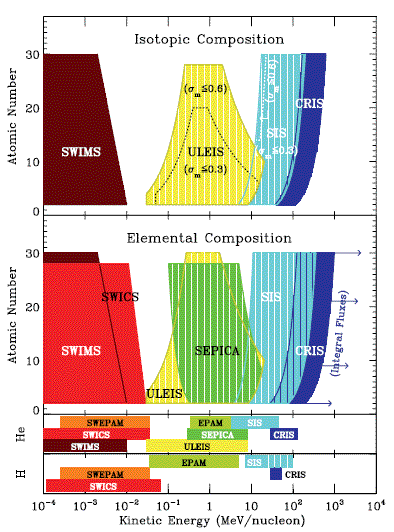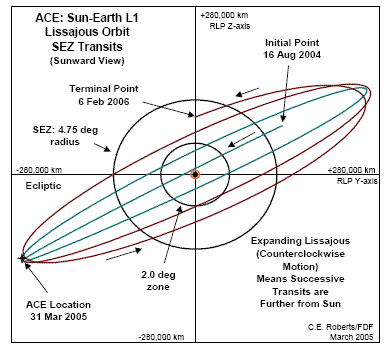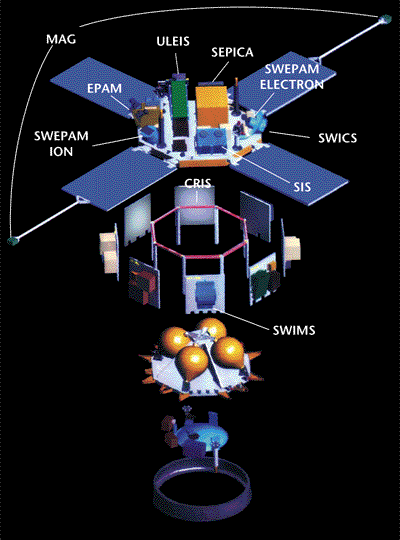
Advanced Composition Explorer (ACE) Mission Overview
Contents
- Mission Summary
- Science Goals
- Current Mission Status
- Mission Orbit and fuel use strategy
- History and Background
- Mission and Spacecraft Characteristics
Related Pages
- ACE Instrument web sites and Space Science Reviews papers
- Detailed Spacecraft and Mission Documentation
- ACE Science Data Center
- ACE Brochure - PDF, describes the ACE mission and science goals.
Mission Summary
The Advanced Composition Explorer (ACE) is an Explorer mission that
was managed by the Office of Space Science Mission and Payload
Development Division of the
National Aeronautics and Space Administration (NASA).
More on the
ACE personnel, including scientific Co-Investigators can be found
here.
ACE launched on a McDonnell-Douglas Delta II 7920 launch vehicle on August 25,
1997 from the Kennedy Space Center in Florida.
The Earth is constantly bombarded with a stream of accelerated particles
arriving not only from the Sun, but also from interstellar and galactic
sources. Study of these energetic particles contributes to our
understanding of the formation and evolution of the solar system as well as
the astrophysical processes involved. The Advanced Composition Explorer (ACE)
spacecraft carrying six high-resolution sensors and three monitoring
instruments samples low-energy particles of solar origin and high-energy
galactic particles with a collecting power 10 to 1000 times greater than past
experiments.
ACE orbits the L1 libration point which is a point of Earth-Sun
gravitational equilibrium about 1.5 million km from Earth and 148.5 million km
from the Sun.
From its location at L1 ACE has a prime view of the solar wind, interplanetary
magnetic field and higher energy particles accelerated by the Sun, as well as
particles accelerated in the heliosphere and the galactic regions beyond.
ACE also provides near-real-time 24/7 continuous coverage of solar wind
parameters and solar energetic particle intensities (space weather). When
reporting space weather ACE provides an advance warning (about one hour) of
geomagnetic storms that can overload power grids, disrupt communications on
Earth, and present a hazard to astronauts.
The spacecraft has enough propellant on board to maintain an orbit at L1
until ~2024.
More details of the ACE mission can be found in the ACE Mission Paper,
published in Space Science Reviews.
View PDF Version (251Kb)

Science Goals
The nine scientific instruments on ACE are performing:
- Comprehensive and coordinated composition determinations
- Elemental
- Isotopic
- Ionic charge state
- Observations spanning broad dynamic range
- Solar wind to galactic cosmic ray energies
(~100 eV/nucleon to ~500 MeV/nucleon) - Hydrogen to Zinc (Z = 1 to 30)
- Solar active and solar quiet periods
- Solar wind to galactic cosmic ray energies
- Investigations of the origin and evolution of solar and galactic matter
- Elemental and isotopic composition of matter
- Origin of the elements and subsequent evolutionary processing
- Formation of the solar corona and acceleration of the solar wind
- Particle acceleration and transport in nature
Mission Status
Last update: January, 2012
ACE has been at the L1 point for over 14 years, and the spacecraft and instruments
are still working very well, with the exception of the SEPICA instrument. Due to
failure of the valves that control gas flow through the instrument, active
control of the SEPICA proportional counter was lost, and delivery of science data from
SEPICA ended on Feb 4 2005. The SEPICA instrument was turned off permanently on
April 20, 2011.
A fuel use strategy has been implemented that will allow continued operations
through the year 2024 (see below).
As of October 2010, 635 peer reviewed papers have been published by ACE
science team members.
See the
ACE Publications List for more information.
Publication-quality data from the ace instruments are available on the web from the
ACE Science Center.
The ACE Education and Public Outreach (E&PO) Committee, in cooperation
with the cosmic ray group at NASA GSFC, has set up a page with ACE and
other E&PO material on the web at: http://helios.gsfc.nasa.gov
Over 140 Science News items have been released by the ACE Science Center.
You can check
http://www.srl.caltech.edu/ACE/ACENews_curr.html
for the latest science news from ACE.
for the latest science news from ACE.
A
Space Science Reviews book that contains all the ACE instrument papers has
been published (vol. 86, Issue 1/4, 1998).
Also, the Advanced Composition Explorer (ACE) Lessons Learned and Final
Report is out and available in pdf form (4.4 MByte).
On January 21, 1998, NOAA
and the ACE project opened up the ACE Real Time Solar Wind (RTSW) monitoring
capability to the public. The service provides continuous coverage of
the solar wind parameters and solar energetic particle intensity.
ACE's position a million miles upstream of earth gives as much
as an hour's warning of CME's that can cause geomagnetic storms
here at earth. See
http://swpc.noaa.gov/ace/index.html

ACE Orbit and Fuel Use Strategy
Three types of maneuvers (attitude, orbit and spin) have been used since July
2001 to control ACE. Orbit maneuvers use 3lbm/year of fuel per year and keep
the spacecraft bound to the L1 libration point. Attitude maneuvers use
6lbm/year and are required to maintain the HGA antenna constraint.
With this strategy, fuel use is 9 lbm/y total, and the 154 lbm of fuel
remaining as of October 2007 will be consumed by year 2024.
Initially, two Z-axis maneuvers using 16 lbm/y were used to prevent the
Sun-Earth-Spacecraft (SES) angle from dropping below 4.75° due to natural
evolution of the Lissajous orbit (see figure at right). This conservative Solar
Exclusion Zone (SEZ) was designed to avoid solar radio interference with the
downlink. As a result of discontinuing the Z-axis maneuvers after July 2001,
ACE transited the SEZ with an SES angle of <2 0.2="0.2" 2003="2003" 2004="2004" 2005.="2005." 21-hour="21-hour" 3="3" 86-hour="86-hour" a="a" ace="ace" although="although" angle="angle" any="any" as="as" capacity.="capacity." commanding="commanding" continued="continued" crossing="crossing" data="data" db="db" disk="disk" during="during" earth.="earth." even="even" every="every" flux="flux" from="from" has="has" in="in" link="link" lost="lost" margin="margin" may="may" minimum="minimum" months="months" nasa="nasa" neither="neither" no="no" noaa="noaa" nor="nor" of="of" p="p" radio="radio" recorder="recorder" reduced="reduced" science="science" september="september" ses="ses" sez="sez" solar="solar" solid-state="solid-state" some="some" spacecraft="spacecraft" telemetry="telemetry" the="the" these="these" thru="thru" to="to" transits="transits" uninterrupted.="uninterrupted." viewed="viewed" was="was" were="were" when="when">
As the Lissajous orbit continues to evolve, the next SEZ transits within 2° will
occur in 2011-2013 at solar maximum. Based on experience during 2003 - 2005,
we expect minimal data loss at solar maximum.
History and Background
ACE was conceived at a meeting on June 19, 1983 at the University
of Maryland. The meeting was hosted by George Gloecker and Glen
Mason. The participants were Drs. L. F. Burlaga, S. M. Krimigis,
R. A. Mewaldt, and E. C. Stone. This meeting had been preceded
by preliminary documentation from the Johns Hopkins University
Applied Physics Laboratory (APL) and the University of Maryland
under the proposal name of Cosmic Composition Explorer.
An unsolicited proposal was put together and forwarded to the
NASA Explorer Program Office later that year, but was not acted
upon.
The proposal was resurrected at the instigation of Dr. Vernon
Jones and officially resubmitted to NASA in 1986 as part of the
Explorer Concept Study Program. In 1988, the ACE mission was selected
for a one-year "Phase A" (concept) Study. This study
was a collaborative effort between spacecraft design and science
teams.
The ACE Mission officially began on 22 April 1991 when the
contract between NASA/GSFC and the California Institute of Technology
was signed. APL, designer and builder of the ACE spacecraft, was
involved in planning for Phase B (definition). The early ACE Spacecraft
effort (April to July 1991) was primarily for ACE mission support,
spacecraft system specification and ACE instrument support and
interface definition. Phase B of the ACE mission officially began
in August 1992.
The Mission Preliminary Design Review was held in November
1993. Phase C/D (implementation) began shortly thereafter.

Mission and Spacecraft Characteristics
The spacecraft is 1.6 meters across and 1 meter high, not including the
four solar arrays and the magnetometer booms attached to two of the solar
panels. At launch, it weighed 785 kg, which includes 189 kg of hydrazine fuel for orbit
insertion and maintenance. The solar arrays generate about 500 watts
of power. The spacecraft spins at 5 rpm,
with the spin axis generally pointed along the Earth-sun line and most of
the scientific instruments on the top (sunward) deck.
ACE launched on a McDonnell-Douglas Delta II 7920 launch vehicle on
August 25, 1997 from the Kennedy Space Center in Florida.
In order to get away from the effects of the Earth's magnetic field,
the ACE spacecraft has travelled almost a million miles (1.5 million km)
from the Earth to the Earth-sun libration point (L1). By orbiting the L1 point,
ACE stays in a relatively constant position with respect to the Earth
as the Earth revolves around the sun.
- Communication Subsystem: Primary Mission, S-band, DSN;
- Communication Subsystem: NOAA - S-band @ NOAA Receiving Stations, TBD
- Total Onboard Data Storage in Two Solid State Recorders -- 2 Gigabits
- Primary Mission Downlink Rates: 78 & 6.9 kbps and 434 bps
- NOAA Real Time Solar Wind Mission: 434 bps
Authors: Eric R. Christian - erc@cosmicra.gsfc.nasa.gov and Andrew J. Davis - ad@srl.caltech.edu
Some content copied from the JHU/APL ACE Page
Curators: ACE Science Center - asc@srl.caltech.edu
Last Updated: Jan 27, 2012
NASA: Advanced Composition Explorer (ACE) Mission Overview - August 2012
Ricardo M Marcenaro - Facebook
Operative blogs of The Solitary Dog:
solitary dog sculptor:
http://byricardomarcenaro.blogspot.com
Solitary Dog Sculptor I:
http://byricardomarcenaroi.blogspot.com
Para:
comunicarse conmigo,
enviar materiales para publicar,
propuestas:
marcenaroescultor@gmail.com
For:
contact me,
submit materials for publication,
proposals:
marcenaroescultor@gmail.com
Diario La Nación
Argentina
Cuenta Comentarista en el Foro:
Capiscum
My blogs are an open house to all cultures, religions and countries. Be a follower if you like it, with this action you are building a new culture of tolerance, open mind and heart for peace, love and human respect.
Thanks :)
Mis blogs son una casa abierta a todas las culturas, religiones y países. Se un seguidor si quieres, con esta acción usted está construyendo una nueva cultura de la tolerancia, la mente y el corazón abiertos para la paz, el amor y el respeto humano.
Gracias :)

No hay comentarios:
Publicar un comentario